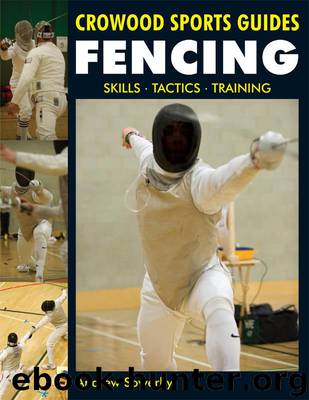Fencing: Skills. Tactics. Training (Crowood Sports Guides) by Sowerby Andrew

Author:Sowerby, Andrew [Sowerby, Andrew]
Language: eng
Format: azw3
ISBN: 9781847978554
Publisher: Crowood
Published: 2014-06-29T16:00:00+00:00
Invitation with Step Forward
From step-lunge distance, you step forward to draw a direct attack, then the point is scored with a lateral parry of quarte with direct riposte. The invitation (the step forward) needs to be convincing to the attacker. They need to believe they will hit with the attack. You must have a good understanding of your opponent’s lunging distance and also the power of their attack.
As previously discussed, direct attacks are very difficult to carry out successfully. Because of their simplicity, attackers know that the distance required to succeed with a direct attack is much closer than their full lunging distance. So when inviting a direct attack, you need to step into a distance that draws the attack. This could be seen as quite a risky strategy. Moving in too close means you get hit; not close enough means are not attacked so much. Practice is needed in getting this right. Once we start to use fencing steps leading up to the invitation, your step that invites needs to be different from all the other steps leading up to it. More about this approach later.
Download
This site does not store any files on its server. We only index and link to content provided by other sites. Please contact the content providers to delete copyright contents if any and email us, we'll remove relevant links or contents immediately.
Shoe Dog by Phil Knight(4168)
The Rules Do Not Apply by Ariel Levy(3906)
Walking by Henry David Thoreau(3234)
Running Barefoot by Amy Harmon(3058)
Crazy Is My Superpower by A.J. Mendez Brooks(2861)
How to Read Water: Clues and Patterns from Puddles to the Sea (Natural Navigation) by Tristan Gooley(2855)
I'll Give You the Sun by Jandy Nelson(2842)
How to Read Nature by Tristan Gooley(2665)
How Music Works by David Byrne(2526)
The Boy, the Mole, the Fox and the Horse by Charlie Mackesy(2452)
Seducing Cinderella by Gina L. Maxwell(2235)
Cuba by Lonely Planet(2185)
The Fight by Norman Mailer(2159)
Going Long by Editors of Runner's World(1921)
Accepted by Pat Patterson(1917)
The Unfettered Mind: Writings from a Zen Master to a Master Swordsman by Takuan Soho(1859)
The Happy Runner by David Roche(1821)
Backpacker the Complete Guide to Backpacking by Backpacker Magazine(1815)
Trail Magic by Trevelyan Quest Edwards & Hazel Edwards(1760)
